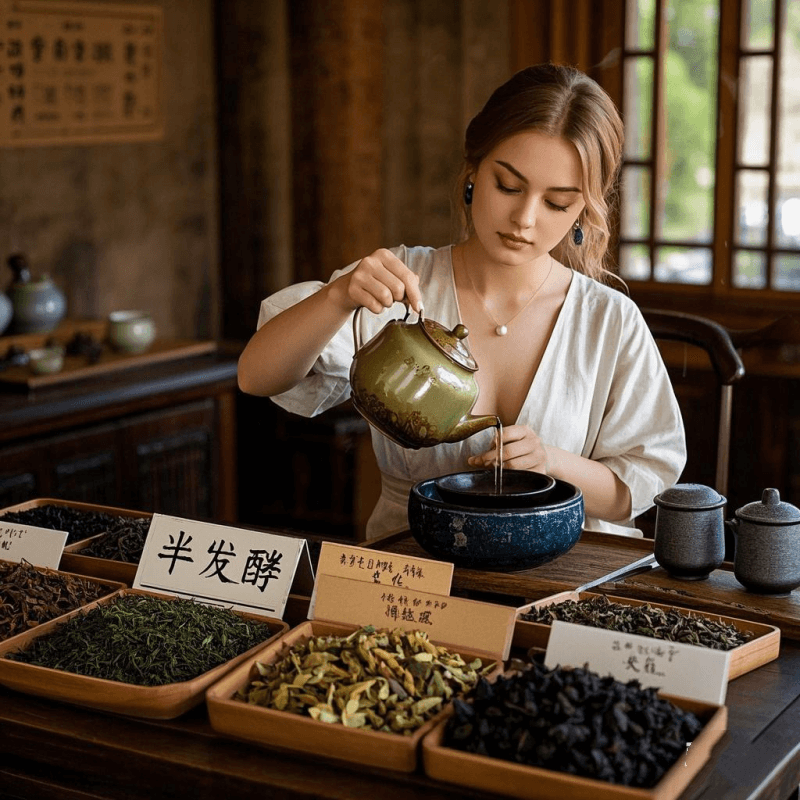In a world where wellness trends come and go, one beverage has quietly maintained its reputation as a healthful staple: oolong tea. Yet, for all its popularity, a simple question persists among curious drinkers: “whats oolong tea?” This query isn’t just about definitions—it reflects a desire to understand the unique role this semi-oxidized tea plays in a balanced lifestyle. From its ancient origins to modern scientific backing, oolong offers a blend of tradition and health that’s hard to match. Let’s dive into what makes it special.
Why “Whats Oolong Tea” Is a Top Question Among Modern Tea Lovers

Walk into any specialty tea shop or scroll through wellness forums, and you’ll notice a pattern: “whats oolong tea?” is one of the most common questions. Why? Because in a market flooded with green juice fads and superfood trends, this brew stands out as a mystery to many. Unlike green tea (touted for its antioxidants) or black tea (a morning staple), oolong exists in a delicious gray area—neither fully oxidized nor unoxidized, with a flavor profile that ranges from floral to toasty.
Modern drinkers are more discerning than ever, seeking not just taste but purpose. They want to know: Is it healthy? How does it differ from other teas? Can it fit into my routine? These questions make “whats oolong tea?” more than a casual inquiry—it’s a search for a beverage that aligns with their wellness goals. As we’ll explore, this semi-oxidized tea doesn’t just answer these questions; it exceeds expectations.
Whats Oolong Tea? A Deep Dive Into Its Origins and Craft
To truly answer “whats oolong tea,” we need to start with its basics: it’s a semi-oxidized tea, sitting between green tea (unoxidized) and black tea (fully oxidized). This oxidation process—where tea leaves are exposed to air to darken and develop flavor—gives oolong its unique character.
Origins and Processing
Oolong traces its roots to ancient China, with legends linking its creation to accidental discoveries: farmers who forgot to dry leaves, letting them oxidize, or monks experimenting with processing techniques. Today, it’s grown primarily in China (Fujian, Guangdong) and Taiwan, with each region producing distinct varieties—think Tieguanyin (floral, buttery) or Da Hong Pao (rich, roasted).
The magic lies in its processing:
- Withering: Fresh leaves are dried to reduce moisture.
- Oxidation: Leaves are rolled or shaken to break cell walls, then left to oxidize (10–70%, depending on the style).
- Fixing: Heat (pan-firing or steaming) stops oxidation, locking in flavor.
- Rolling and Drying: Leaves are shaped (twisted, curled, or flattened) and dried to preserve their profile.
This careful craft explains why “whats oolong tea?” often leads to discussions of terroir and tradition—each cup tells a story of place and practice.
Discover the unique depth of oolong tea in our curated collection—our varieties span light to dark oxidations, letting you explore the full spectrum of this versatile brew.
The Powerful Health Benefits of Oolong Tea: Backed by Science
Beyond flavor, this semi-oxidized tea’s reputation rests on its health benefits. Research highlights several key advantages:
1. Boosts Metabolism and Aids Weight Management
Studies show oolong may enhance fat oxidation. A 2009 study in the Chinese Journal of Integrative Medicine found that daily consumption increased energy expenditure by 10–12% over 24 hours, potentially aiding weight loss. This is linked to catechins (antioxidants) and caffeine, which work together to stimulate metabolism (learn more about tea and metabolism here).
2. Supports Heart Health
Oolong may help lower LDL (“bad”) cholesterol while raising HDL (“good”) cholesterol. A 2014 review in The American Journal of Clinical Nutrition noted that regular drinkers had a 20% lower risk of cardiovascular disease, thanks to compounds that reduce inflammation and improve blood vessel function. For more on herbal remedies and heart health, explore WebMD’s guide to tea benefits.
3. Stabilizes Blood Sugar
For those managing blood sugar, this brew offers promise. A small study in Diabetes Research and Clinical Practice found that drinking it with meals reduced post-meal glucose spikes by 15–20%, likely due to its ability to slow carbohydrate absorption.
4. Rich in Antioxidants
Oolong contains a unique mix of antioxidants, including theaflavins and thearubigins (more than green tea) and catechins (more than black tea). These fight free radicals, protecting cells from damage linked to aging and chronic disease.
Oolong Tea vs. Green and Black Tea: Health Comparisons
To understand this semi-oxidized tea’s uniqueness, let’s compare it to its better-known counterparts:
| Aspect | Oolong Tea | Green Tea | Black Tea |
| Oxidation | 10–70% (semi-oxidized) | 0% (unoxidized) | 100% (fully oxidized) |
| Antioxidants | Balanced catechins + theaflavins | High catechins | High theaflavins/thearubigins |
| Caffeine | 30–50mg/cup | 20–45mg/cup | 40–70mg/cup |
| Metabolic Boost | Moderate-to-strong | Moderate | Mild |
| Flavor | Versatile (floral to toasty) | Grassky, fresh | Bold, malty |
What sets oolong apart is its “middle ground” status—it offers the antioxidant punch of green tea with the smoothness of black tea, making it ideal for daily drinking without overwhelming the palate. And this brings us back to a key point: when people ask “whats oolong tea?”, part of the answer lies in this rare balance.
How to Enjoy Oolong Tea in Daily Life: Tips and Rituals
Incorporating this semi-oxidized tea into your routine is simple, whether you’re a beginner or a seasoned drinker:
1. Brewing Basics
- Water Temperature: 185–205°F (85–96°C) (lower for light oolong, higher for dark).
- Steeping Time: 3–5 minutes (avoid over-steeping to prevent bitterness).
- Ratio: 1–2 teaspoons per 8oz water.
- Vessel: A clay teapot or glass infuser works best to highlight aroma.
Steep oolong tea the traditional way with tools from Yihe—our teapots are designed to control temperature and extraction, ensuring the perfect cup.
2. Best Times to Drink
- Morning: A cup with breakfast boosts metabolism without the jitters of coffee.
- Afternoon: Replaces sugary snacks with a satisfying, low-calorie pick-me-up.
- Post-Meal: Aids digestion, thanks to compounds that support gut health.
Many who’ve explored “whats oolong tea?” find that its versatility makes it easy to weave into daily life—no strict rules, just enjoyment.
User Stories: How Oolong Tea Transformed Wellness Routines
Real-life experiences highlight this brew’s impact:
- Sarah, 32, fitness coach: “I replaced my afternoon soda with oolong three months ago. Not only do I have more steady energy, but I’ve also noticed better workout recovery—science-backed or not, it works for me!”
- Michael, 45, office worker: “I used to struggle with afternoon slumps. Now I keep a teapot at my desk. This tea gives me just enough energy to finish the day without disrupting my sleep. It’s made me finally understand why people ask ‘whats oolong tea?’—it’s a game-changer.”
- Lina, 28, nutrition student: “I started drinking oolong to manage my blood sugar. Pairing it with meals has made a noticeable difference in how I feel—less energy crashes, more stability. Now I recommend it when friends ask ‘whats oolong tea?’”
Explore Oolong Tea for Wellness: Premium Varieties

Not all oolong is created equal. Quality matters for both flavor and health benefits, as fresh, high-grade leaves retain more antioxidants.
Explore the premium oolong tea varieties selected for wellness—our collection includes organic, single-origin options, each tested for purity and potency. For those who value ritual, Shop authentic teaware designed to elevate your oolong tea ritual—proper tools enhance extraction, ensuring you get the full spectrum of benefits in every sip.
Conclusion: Why Oolong Tea Belongs in Your Healthy Lifestyle
So, whats oolong tea? It’s more than a beverage—it’s a bridge between tradition and science, offering flavor, versatility, and wellness in every cup. Its unique oxidation process creates a tea that’s neither too mild nor too bold, making it easy to enjoy daily. Backed by research and loved by drinkers worldwide, this semi-oxidized tea proves that the best health habits are those that taste good, too.
Whether you’re curious about its origins, seeking metabolic support, or simply want a delicious alternative to sugary drinks, oolong delivers. Start small—brew a cup, savor its complexity, and let its benefits unfold. And the next time someone asks you “whats oolong tea?”, you’ll have a story to share.
Whats oolong tea? Discover this semi-oxidized tea’s unique health benefits—metabolic boost, heart support, and more. Learn why oolong tea stands out for daily wellness.
